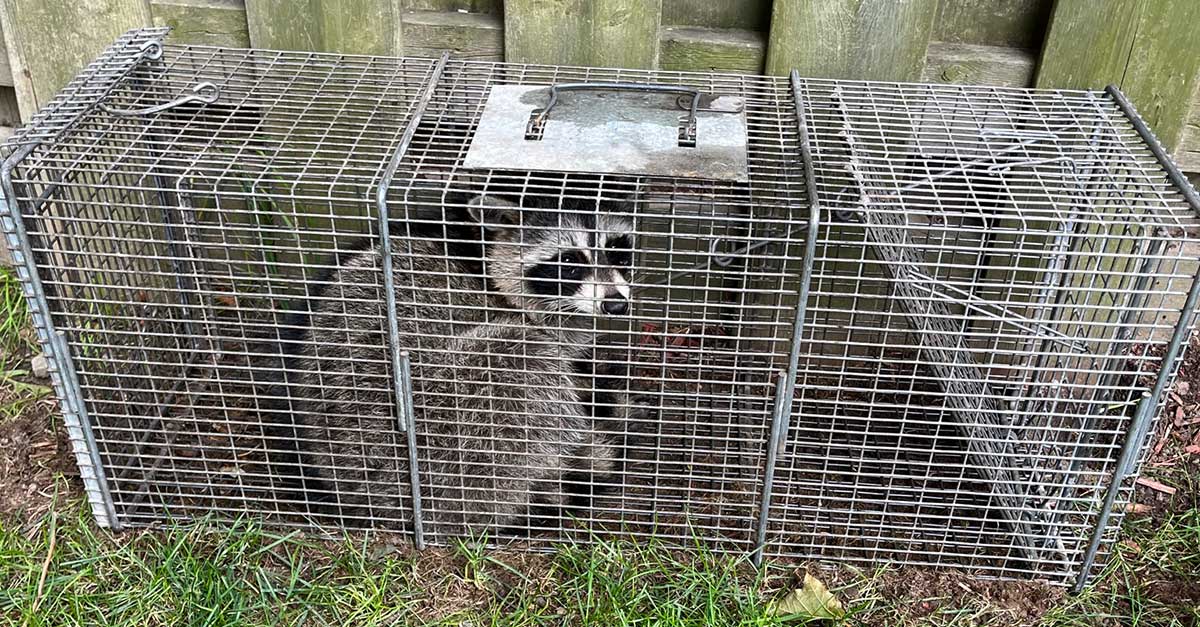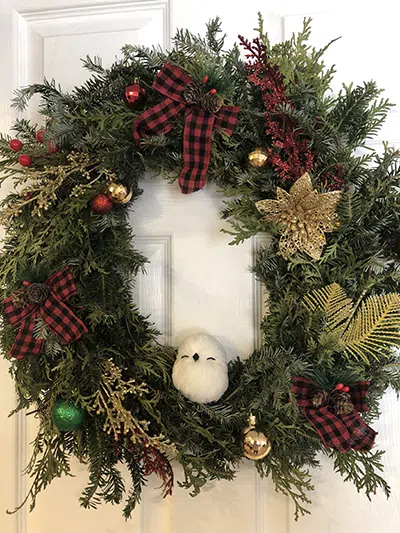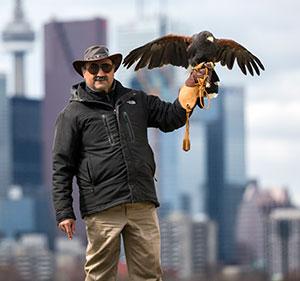Raccoons are known for their intelligence and dexterity, which can make them quite a challenge to catch. Whether you're dealing with a pesky raccoon rummaging through your trash or an unwelcome visitor in your attic, using a live trap is often the most humane and effective method for removal.
Let’s explore how to catch a raccoon in a live trap in a humane and efficient way.

Below, we outline some of the key factors that professionals consider when using live traps to remove raccoons from a property.
Get a Raccoon Trap
When you need to know how to catch a raccoon in a live trap, there are several features to consider. The size of the trap should be large enough to comfortably contain the raccoon without causing injury.
Specifically, look for traps that are at least 30 inches long, 12 inches high, and 10 inches wide. Durability is another key factor, as raccoons are strong animals that can easily escape from or damage flimsy traps. Opt for traps made from sturdy materials like heavy-duty steel.
Safety mechanisms are also crucial when catching raccoons. The trap should have smooth internal edges to prevent injury to the animal and a sensitive trigger to ensure the door closes securely. Some traps are designed with a double-door feature, which can increase the chances of a successful capture.
There are several reputable brands and types of traps suitable for raccoons, including Havahart or Tomahawk. Each has its own set of features, so it's worth researching to find the one that best suits your needs.
As for purchasing or renting a trap, many hardware stores or home improvement centers sell live traps, and some may even offer rental services. Online retailers are another convenient source, offering a wide selection of traps with detailed descriptions and reviews to help you make an informed decision.
Types of Raccoon Traps
When it comes to trapping raccoons, there are primarily two types of traps to consider: cage or box traps and foot-hold traps (only legal in certain areas). Each has its own set of advantages and disadvantages, and understanding these can help you choose the most suitable option for your situation.
Cage Traps
This is the most commonly used type when looking for how to catch a raccoon in a live trap. They are typically made of wire mesh and have a trigger mechanism that closes the door when the raccoon steps on it to reach the bait. Cage traps are available in various sizes, but it's important to choose one that is large enough to accommodate the raccoon comfortably. In some areas, cage traps must be covered. Traps must ALWAYS be checked regularly (it’s a good idea to take a quick photo of your trap every morning).
Pros: Cage traps are designed to capture raccoons without causing harm, making them a preferred choice for those who wish to remove wildlife humanely. They are also safe to use around pets and children, as there are no exposed sharp parts or mechanisms that could cause injury.
Once a raccoon is captured and relocated, the trap can be reset and used again.
Cons: Cage traps can be large and cumbersome, making them difficult to transport and set up in tight spaces. The trap's size and shape also make it noticeable, which might alert the raccoon and make it wary of approaching. Also, previously trapped raccoons become ‘trap shy’ - they are smart and have an excellent memory.
Box Traps
Pros: Box traps are appropriate in colder months and/or climate as they provide an enclosed space and better shelter from the elelements.
Cons: Box traps should ONLY be used in cold temperatures, as they can easily overheat and put the captured animal at risk.
Foot-Hold Traps*
*Traps with teeth are illegal in Canada. These are traditional traps that capture an animal by its foot or leg. They are less commonly used for raccoons and are typically employed by professional trappers or in rural areas. Please check your local, provincial, and federal laws. In some areas, foot-hold traps are illegal altogether.
Multi-Catch Traps
Multi-catch traps are designed to capture multiple animals at once and are often used by professional wildlife removal services. This type of trap uses a gravity-operated repeating trap door that allows for multiple “trips” without allowing the captured raccoon(s) to escape. It is designed to be used in tight spaces or on roofs and in chimneys, where families of raccoons are often found.
Figure Out Where to Put the Trap
Choosing the right location for your raccoon trap is crucial for a successful capture. There are several factors to consider when determining where to place the trap:
- Observe signs of raccoon presence, such as tracks, droppings, or property damage. Placing the trap near these areas increases the likelihood of catching the raccoon.
- Ensure the trap is easily accessible for you to check regularly, but also in a spot where raccoons feel safe to approach. Avoid high-traffic areas that may scare them away.
- Consider the safety of both the raccoon and any people or pets around. The trap should be placed in a stable position where it won't tip over or injure the animal.
Where to Put a Raccoon Trap
To increase your chances of trapping a raccoon, consider placing the trap in the following locations:
- Near trash cans: Raccoons are often attracted to garbage for food. Placing a trap near trash cans can lure them in.
- Near gardens: If you've noticed damage to your garden or fruit trees, setting a trap nearby can help catch the culprit.
- Known entry points: If raccoons are entering your attic or crawlspace, placing a trap near these entry points can be effective.
- Along fences or walls: Raccoons tend to follow paths along fences or walls, so positioning your trap along these routes can be strategic.
Where NOT to Put a Raccoon Trap
There are also some locations you should avoid when setting up your trap:
- Areas accessible to pets or children: To prevent accidents, keep the trap away from places where pets or children might encounter it.
- In direct sunlight: Avoid placing the trap in direct sunlight, as this can cause overheating and stress for the captured raccoon.
- Near water sources: Setting a trap too close to a pond, stream, or pool can pose a drowning risk if the trap tips over.
- In public spaces: Avoid placing traps in public areas where they might be tampered with or pose a hazard to others.
Bait Your Trap
Raccoons have a sweet tooth, so many people refer to big marshmallows as the best bait to catch a raccoon. Peanut butter and jelly works, too! They're also attracted to the scent of sweet corn, so a few kernels can be very effective. If you're dealing with a raccoon that seems to prefer a more savory menu, try using sardines or smelt. Any bait should be able to be secured to trap by zip tie or something similar.
Now, let's talk about placement. You want to place the bait at the far end of the trap, beyond the trigger plate, and suspended from the trap roof, if possible. This encourages the raccoon to step on the plate as it reaches for the bait, ensuring the trap door closes behind them.
To make the bait even more enticing, you can smear a little on the walls of the trap leading up to the main stash. Just make sure not to put too much bait near the entrance, or the raccoon might be able to grab a snack without fully entering the trap.
Check Your Trap
It's important to check your trap regularly, at least twice per day. This is not only humane, but it also reduces the stress on the captured animal. Depending on the area of Canada you’re in, there is likely a requirement for checking the animal within a certain time span. It’s a good idea to take a photograph daily.
If you've caught a raccoon, you can then proceed with relocating it according to your local wildlife regulations. This is usually within one kilometer of capture.
However, sometimes you might catch an animal you didn't intend to, like a stray cat or a different type of wildlife. If this happens, don't panic. Approach the trap calmly and cover it with a blanket or towel to help calm the animal. Then, carefully open the trap door and allow the animal to leave on its own. It's always a good idea to wear gloves when handling the trap to protect yourself from potential bites or scratches.
Remember, the goal of trapping and relocating raccoons is to resolve conflicts between humans and wildlife in a safe and humane manner for both parties.
Release the Raccoon
Once you've successfully learned how to catch a raccoon, you’ll need to release it safely and legally. Legal requirements state that a raccoon must be released within 1 km of the trapping location. Licensed wildlife control services can legally and permanently remove the animal if relocation is not desired at the homeowner’s request. The 1 km relocation radius is also of vital importance due to the spread of rabies and raccoon roundworm. Diseases can easily be spread from point 'A' to point 'B' and rabies is 99% lethal to humans.
When selecting a release site, look for a suitable habitat that provides ample food sources, water, and shelter for the raccoon. An area with dense vegetation near a water source is ideal.
Before releasing the raccoon, wear protective gloves to minimize the risk of bites or scratches. Open the trap door carefully using metal tools and allow the raccoon to exit by itself. Do not use your fingers, even with protective gloves on. Do not attempt to force the raccoon out or handle it directly. Once the raccoon has left the trap, retreat to a safe distance and observe until it has moved away from the area.
Hawkeye: A Safe & Humane Way to Get Rid of Raccoons!
Now that you know the many steps of how to catch raccoons in a live trap, you might be wondering how to make the process easier. Dealing with raccoons can be challenging, and sometimes it's best to call in the professionals. Hawkeye is a professional wildlife removal service that knows how to catch a raccoon in a live trap, specializing in safe and humane measures.
Our team at Hawkeye has proven strategies to capture and relocate raccoons, ensuring the safety of both the animals and the residents. Additionally, Hawkeye can advise on preventing future raccoon issues, such as securing garbage bins and sealing entry points. Call us today!














